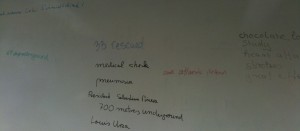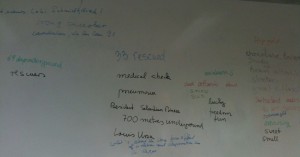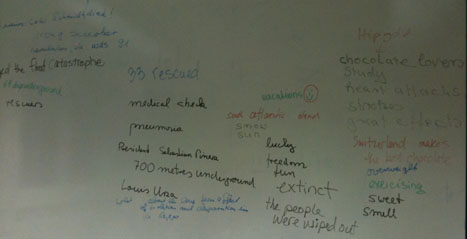Jason Renshaw, @EnglishRaven, has challenged educators to complete several “teaching unplugged” tasks. This refers to the Dogme theory of teaching that supports teaching language in a way that is conversation driven, materials light, and dependent upon emergent language. Ironically, the lesson I chose to replicate did not involve technology either, which I am not sure is intentional on Jason’s part. Jason’s recent The Wandrous Whiteboard Challenge is quite simple to try with no technology. I love integrating technology effectively in my lessons, but I’m not glued to it and I try to give my students a mixture of lessons with and without technology. What attracted me to Jason’s recent suggestion was that in its simplicity it checked all the right boxes- the preparation was minimal, the students provided the ideas, the students applied their learning, and it was very student centered with me acting as a facilitator.
My Students’ Unplugged Interaction Whiteboard
What is it?
Simply, give each student a whiteboard marker and let them write an idea on the whiteboard. Originally, Jason suggests in his post a topic is not needed, however, my German students decide on the topics we discuss in our English classes so we had already decided on a theme, News Anything (Current Events). On our wiki, students were given a list of websites where they could find news articles in simple English from either Germany or worldwide. When I found out about Jason’s idea, I thought why don’t I have the students write down anything they want about the news they chose to bring to the class. Below is what our original board looked like.
My spin on this lesson…
I asked Jason if I could add my own flavor to his original idea and he was very supportive and encouraging. Here were some of the details for this initial wall:
- This was my upper-intermediate adult English class of 10 students
- Students were told to write anywhere on the board as much or little as they wanted
- Each of my students were given a whiteboard marker and as a group we all wrote on the whiteboard instead of one by one
- We stayed at the whiteboard for the discussion because conversation sparked up immediately
What I observed from my students:
- The ones who had completed their wiki challenge (essentially what I call their optional homework) wrote a lot because they wanted to show they had completed the work
- The ones who hadn’t had time to complete their challenge were still able to participate
- I know they didn’t complete the challenge because they asked me if they could write on the board if they hadn’t researched any news and I told them sure just write about anything you’ve heard that is considered news
- All immediately made remarks about the written words when they finished writing and observed what their peers had written
- One of the best comments that sparked a dialogue at the board was in reference to the death news. Another student commented, “Who’s that?” which encouraged the original creator of the story to tell us about the person, but the news details weren’t covered.
- The students were a bit hesitant at first that it was haphazard and that they could write anywhere on the board rather than in categories
- The majority of the students wrote their thoughts in an organized way as you can see on the board
- None of them wrote sentences, but one did write a headline
- This was a great way to get the students to reflect on their homework and summarize it for the rest of the class
- I liked this approach rather than a round table discussion because often the students lose interest when others relate the news
- My students practiced language related to the news and also practiced writing skills
- Students asked questions without my prompting
After awhile of initial conversation, I told students to write something about the other students writings even if they weren’t familiar with the news. At this point, no one had exactly told what their news was about. They just had initial conversations over what was written on the board. This is what the next boards looked like. The final board shows student corrections:
- Students were more comfortable that they didn’t have any rules. One student added a smiley face in reaction to another student’s comment about vacations on his initial post, “South Atlantic Islands”
- The students corrected the errors we noticed written on the board. I didn’t do the corrections just pointed out any areas of language they may have missed.
- After completing the last board we sat down and had our round table discussion.
- Immediately, students began sharing information, reactions, and anecdotes related to each story. I didn’t say a word just wrote down any errors for feedback at the end of the lesson.
- All students contributed to the conversation and we learned so much, including me!
- One great thing about having students pick their own news is that they brought other items!
- The student who choose the Chocolate research story from Sean Banville’s Breaking News English website brought us some chocolate to enjoy during the lesson! 🙂
- The students really enjoyed teaching each other and some of the students who had initially not added much to previous conversations were very enthusiastic sharers in this lesson!
- Students were able to practice speaking, listening, and writing skills!
Teching this Activity Up!
After reflecting on this lesson I did think about how this could also work with technology in case you’re just in love with using technology like I am! Hope Jason doesn’t kill me for this!
- Easily have students add the ideas on an interactive whiteboard.
- Use Wiffiti to enter their ideas to an LCD projected website or interactive whiteboard via their mobile phones! Teens and young learners who have cell phones will love doing this!
- As a follow-up to this in class lesson take pictures of each item and have students go on Voicethread and circle the item with the doodling tool and make audio, video, or written comments. They can add more news stories and ask other classes to join in!
So you don’t teach English…
This activity can be applied to any subject to spark class discussion with student knowledge emerging. In the lesson, I found students were able to share their previous knowledge and experience in reference to the news stories of others. They were also able to write key points of what they had read previous to the class. They personalized the learning and applied it within a context! That was the beauty of the lesson in my opinion! They also greatly enjoyed the lesson. We went over the class time. Here are ideas on how to apply to your subject:
- Do you have assigned readings from the textbook? Have students each take a subheading and be responsible for that. Then apply this lesson.
- Do your students have assigned readings from a book? Have each write anything on the board about what they read.
- Do your students have assigned math word problems? Have them write about any of the ones they remembered or struggled completing. Great way to discuss the difficult language in word problems. You can even see if they can guess the word problems the others are describing.
- At the beginning of class have students write about any challenges they had with the homework they were assigned. They can they help each other and you can give them time to work these problems out before taking up the homework.
- Have students discuss your subject before you teach it. This is easy for history where students can brainstorm about what they know from movies, books, or video games they played in that era.
Challenge
Try Jason’s Wandrous Whiteboard lesson using any subject matter. See the conversations that spark about the learning achieved.











